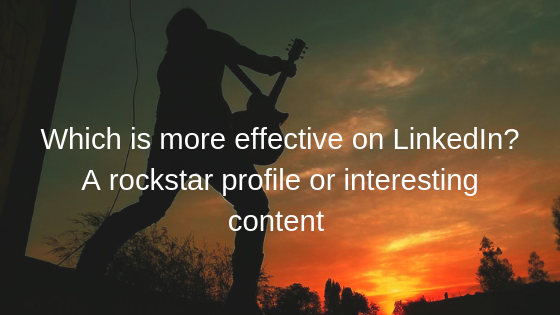Which is more effective on LinkedIn? A rockstar profile or interesting content
The short answer is you need to do both. To become a credible connection on LinkedIn you need to optimise your personal profile AND create interesting organic content.
Doing one without the other is like chucking a pebble in a river. You’ll only create a few ripples. Combining both elements is like throwing a large rock in that river. You’ll make a big splash and the tidal waves will travel far and wide.
Here’s how to create the LinkedIn footprint of someone people know, like and trust to do business with.
The 4 essential elements of a LinkedIn profile
Let’s start with the basics. As a minimum, your profile should include a:
Banner image
Head and shoulders photograph
Headline
Profile summary
Images
With the two images you want to create a good first impression. Your banner might include company branding, a favourite quote, or a photo montage of the products you sell.
Tip: Choose one of these, not all three! LinkedIn shrinks banners for mobile devices so keep it simple and always check your image is legible on the app.
In your profile photograph you should be looking at the camera and use a plain background where possible. There is much value in paying a professional to take this photograph. You only get one chance to make a first impression and you’ll be able to use the photograph on other materials to get more bang for your buck.
One of my pet hates on LinkedIn is seeing photographs of people holding a glass of wine or reclining on the beach. LinkedIn is a professional platform so unless you do wine tasting for a living, steer clear.
Headline and profile summary
The Headline and Summary fields are both searchable within LinkedIn and via search engines like Google. By including the keywords and search terms you want to be found for in these sections, you should see an increase in profile views.
My second pet hate on LinkedIn is a business-to-business profile that reads like a CV. You might have used LinkedIn to find your dream job in the past. But when you’re selling a product or a service, it’s vital to adapt your profile to speak directly to your target audience. Customers want to know what you do and how you can help them. If they identify themselves in your profile that’s step one to building likeability and trust.
How to write a quality LinkedIn profile
I’ll let you in on a little secret… When I’m writing a LinkedIn profile, there are a few questions I ask myself:
Is it easy to understand what they do?
How does the person approach their work?
What kind of clients do they work with?
Have I added current contact details?
Is it written in plain English?
Ask yourself these same questions as you write and you won’t be far off rock stardom! Above all, use your profile to show off your personality and tell your story.
Tip: You have up to 2,600 characters to write your profile summary. That’s equivalent to around 5-6 short paragraphs. No scrimping - use them all!
Ready to take it one step further?
There are other profile elements that aren’t essential for search but still worth reviewing to build a credible profile. Most of us have legacy items that would benefit from an update.
Are your contact details up to date?
This is an easy one to start with. Use your work email and phone number where possible and always add a link to your website.
Do your interests and group memberships reflect your current profile?
If you’ve changed roles or sectors, it’s likely you’ll have interests or memberships that no longer reflect what you do. It takes 5 minutes to review and refresh.
Are your recommendations recent?
A handful of recommendations from five years ago aren’t going to cut the mustard. Prospective clients want to know you’re a consistent performer. Just use the ‘Ask for a recommendation’ button and choose whom to send it to. Asking for feedback is possibly one of the hardest things to do as a business owner. The majority of contented clients will be only too happy to provide a testimonial.
Does your experience back up what you’ve written in your summary?
You can write a cracking profile summary, only for your experience section to let you down. If you leave this blank, or add roles with no description, an interested client could feel somewhat let down. It’s not essential but I think it’s worth spending time on if you want to be noticed.
What do we mean by organic content?
Organic posts are original, new content – posts you’ve written yourself from scratch. It’s the polar opposite of liking, sharing or commenting on someone else’s post. That’s easy to do – and we probably do it in our sleep! Actively engaging with content is important but choose the posts you interact with wisely. All this activity shows on the ‘Articles and Activity’ section of your profile so be careful to engage with content that you want to be associated with – personally and professionally. Have a content engagement strategy!
Creating your own original content not only shows thought and consideration. It’s an opportunity to showcase your knowledge and the values that are important to you. I always talk about quality content being valuable and relevant to your audience. The content you write and share should reflect the persona you’re looking to achieve.
Need help writing your LinkedIn profile?
Avoid the wine photo and the CV style summary and you’re already heading towards rockstar status in my eyes! But if you’re struggling and would like some assistance to tell your story, please get in touch.
My profile package includes a short interview, drafting content and tips to improve your profile.
#LinkedIn #linkedin #profile #CV #contentcreation
